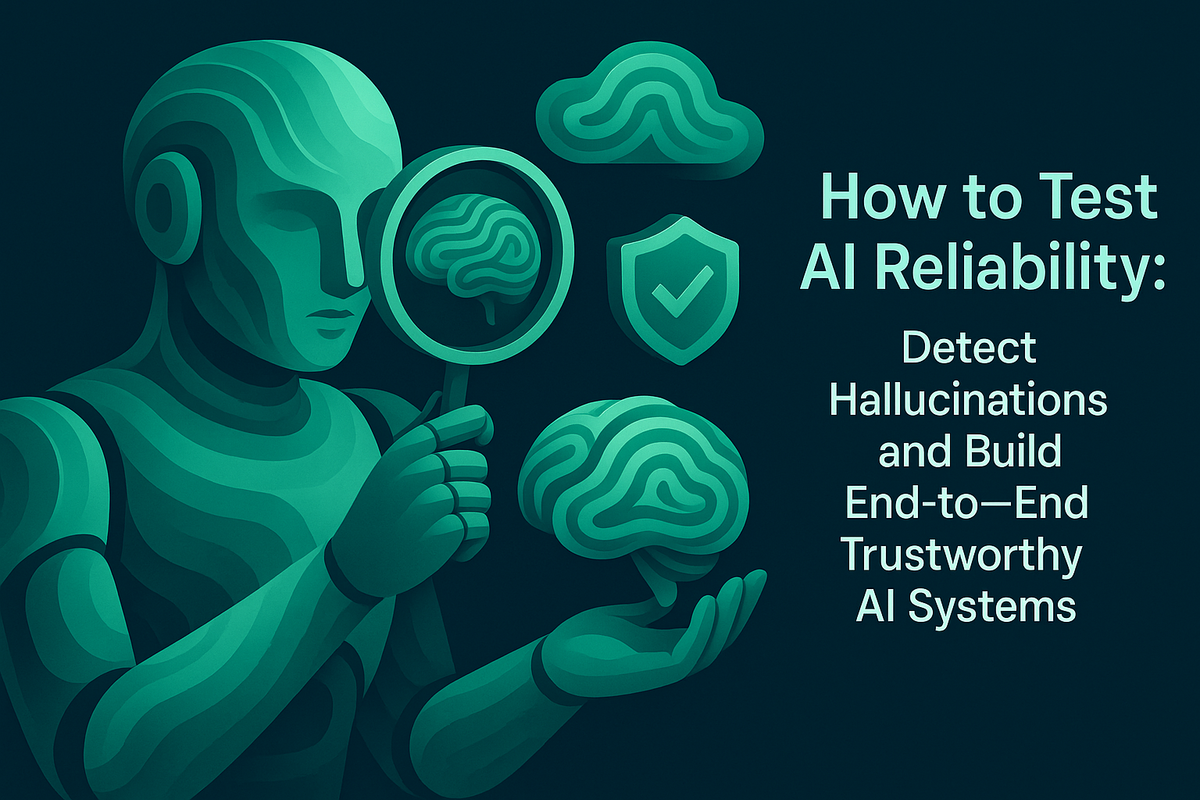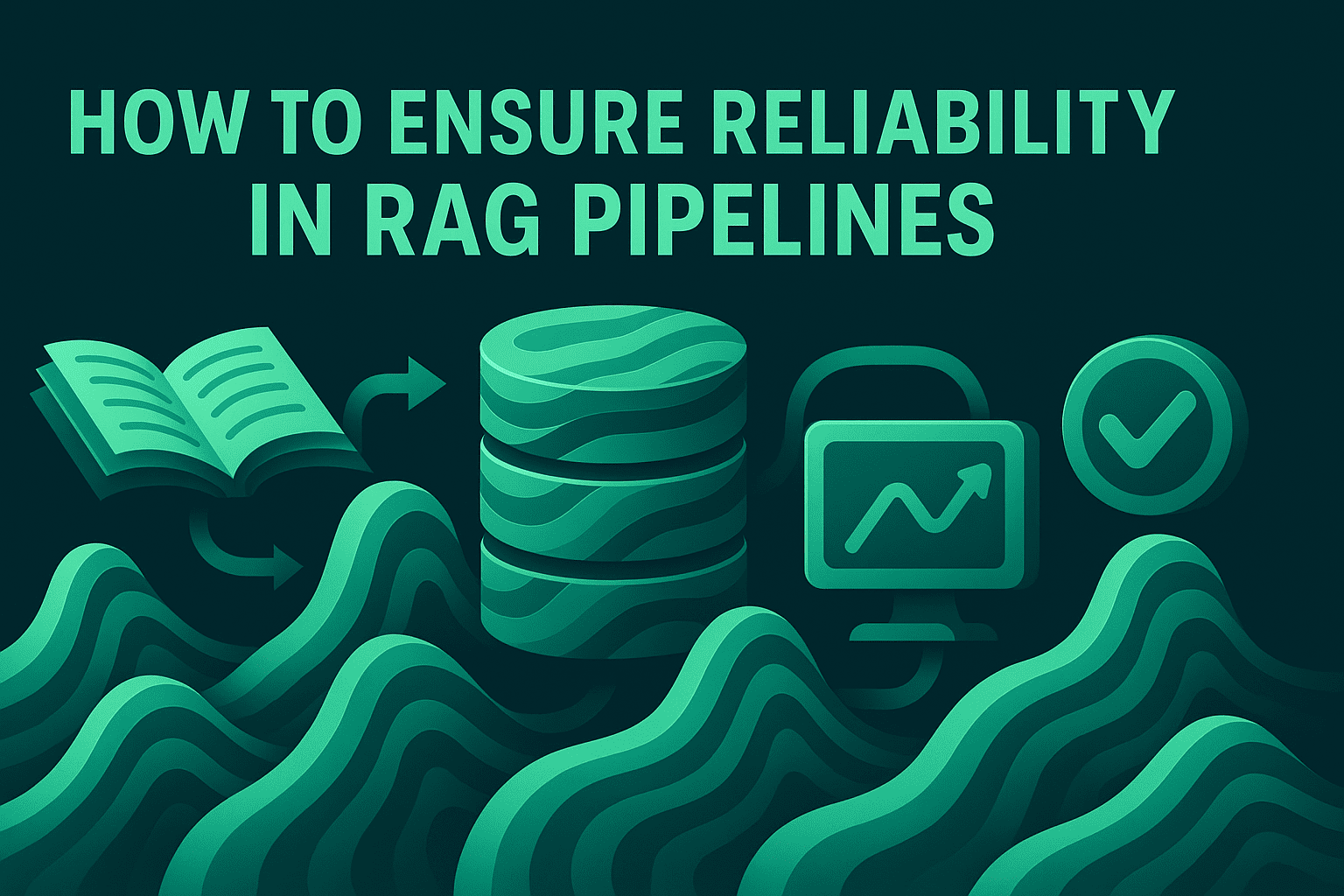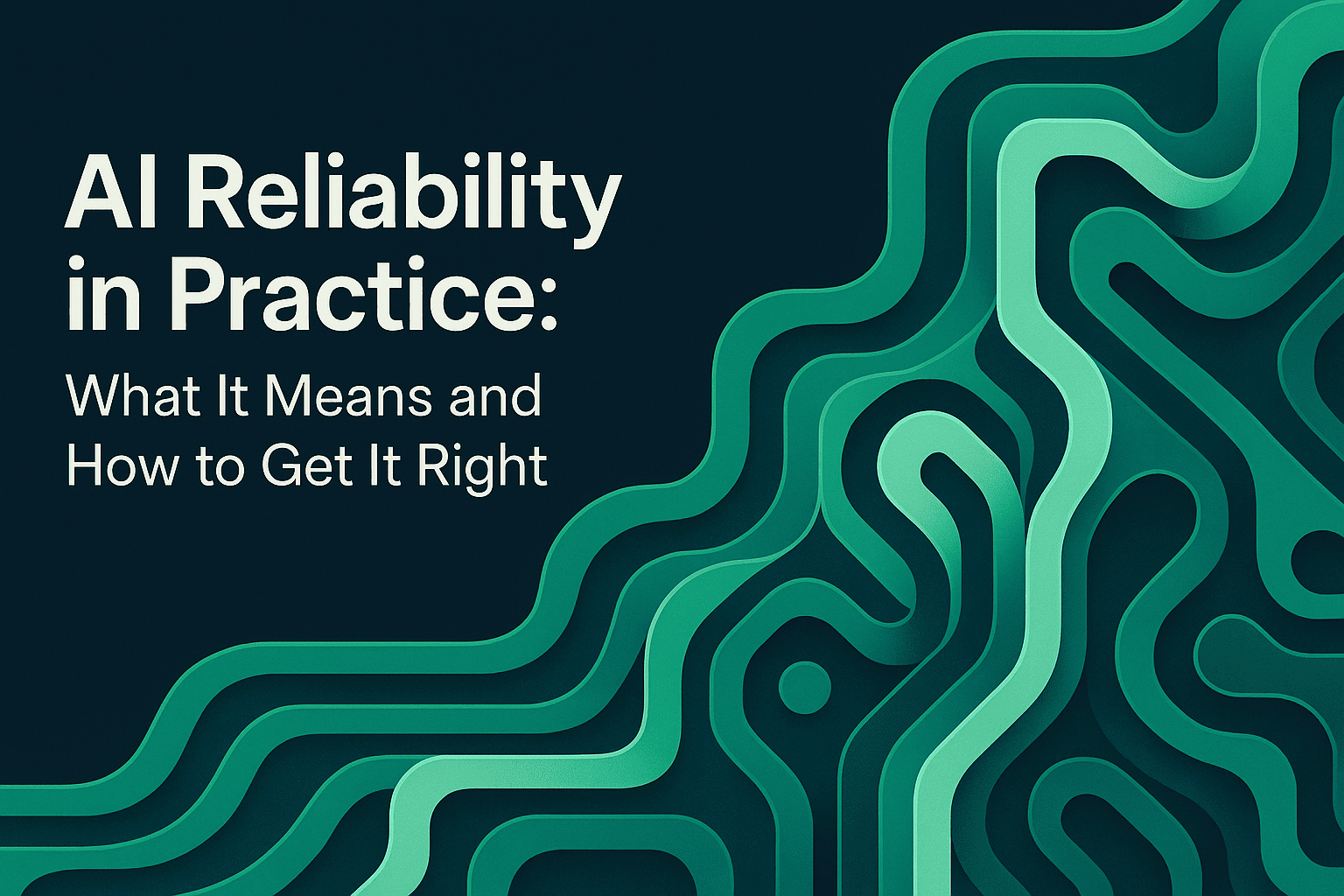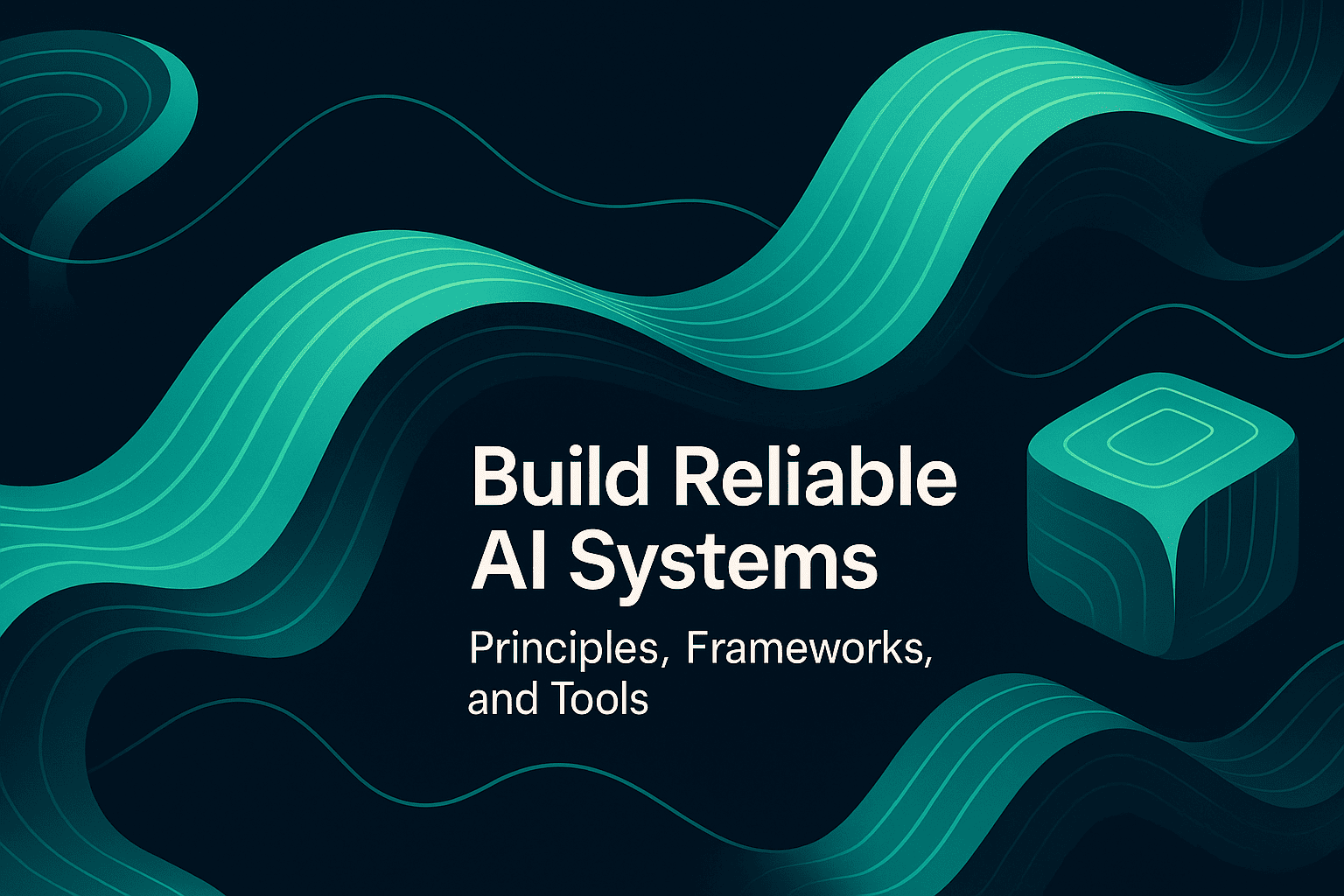How to Test AI Reliability: Detect Hallucinations and Build End-to-End Trustworthy AI Systems

TL;DR
AI reliability requires systematic hallucination detection and continuous monitoring across the entire lifecycle. Test core failure modes early: non-factual assertions, context misses, reasoning drift, retrieval errors, and domain-specific gaps. Build an end-to-end pipeline with prompt engineering, multi-turn simulations, hybrid evaluations (programmatic checks, statistical metrics, LLM-as-a-Judge, human review), and distributed tracing with online alerts. Strengthen reliability through layered hallucination detection, evidence attribution, structured output contracts, and grounding constraints. Combine automation with human oversight for high-stakes domains. Make reliability a continuous discipline, not a one-time milestone.
Modern AI agents power customer support, analytics, and autonomous workflows. Reliability is the threshold for production readiness. This guide shows how to detect hallucinations, instrument end-to-end evaluation workflows, and operationalize trustworthy AI through agent-centric testing, observability, and governance.
What AI Reliability Means in Practice
AI reliability is the consistent delivery of accurate, grounded, and safe outputs across varied scenarios, inputs, and user intents. Hallucinations are the primary failure mode: plausible content that is factually incorrect or unsupported by evidence. Reliability requires systematic detection of these errors during development and continuous monitoring in production.
Robust evaluation stacks combine programmatic checks, statistical metrics, LLM-as-a-Judge, and human review to quantify truthfulness, groundedness, coherence, and safety across multi-turn interactions. This aligns with an agent-level lens where correctness depends on the full trajectory, tool calls, and context handling rather than a single prompt-output pair.
Core Failure Modes to Test Early
Reliability tests should target the most common and impactful defects:
- Non-factual assertions that contradict authoritative sources or lack citations in RAG and tool-augmented pipelines.
- Context misses, where agents ignore instructions, retrieved evidence, or user constraints, leading to ungrounded responses.
- Reasoning drift across multi-step tasks, including incorrect tool calls, broken chains of thought, or inconsistent intermediate state.
- Retrieval errors such as off-target chunks, insufficient overlap, or outdated knowledge that push agents to fabricate details.
- Domain-specific correctness gaps that require subject matter expert review when LLM-as-a-Judge alone is insufficient.
Ground these tests in agent behavior and user journeys rather than single-turn prompts, using trajectory-level checks that reflect how agents fail under real load.
Build an End-to-End Reliability Pipeline
A production-grade pipeline spans pre-release experimentation, large-scale simulation, evaluation, and runtime observability. Each layer contributes a different assurance:
- Prompt engineering and versioning for deterministic structure, explicit grounding rules, and controlled decoding. Use low temperature for factual tasks, add “must-cite” constraints, and enforce structured formats for validation friendliness.
- Scenario-based simulations across personas, tasks, and edge cases to surface reasoning drift and tool misuse before launch. Configure multi-turn datasets that replicate production workflows and capture recovery behavior under errors.
- Hybrid evaluation with programmatic checks for groundedness and safety, statistical metrics for coherence, LLM-as-a-Judge for scalable qualitative scoring, and human-in-the-loop review for expert domains. Maintain session, trace, and span-level granularity to localize failures precisely.
- Observability with distributed tracing to inspect tool calls, retrievals, and intermediate outputs, plus online evaluations and quality alerts on live traffic. Correlate hallucination rates with prompt versions, personas, and features to guide remediation.
Detect Hallucinations with Layered Evaluations
Hallucination detection benefits from complementary detectors that capture distinct risks:
- Consistency checks sample multiple generations for the same query. Divergence across samples indicates uncertainty and likely non-factual content. Gate responses when contradiction scores exceed thresholds and fall back to retrieval or abstention.
- Evidence attribution verifies sentence-level alignment of claims to retrieved passages or tool outputs. Penalize unverifiable spans and flag responses that ignore supplied context.
- Benchmark-aligned measures test truthfulness on standard suites and domain-specific corpora, extending with application-tailored evaluators that check business rules, safety constraints, and compliance needs.
- LLM-as-a-Judge offers scalable grading of helpfulness, coherence, and faithfulness. Calibrate judges with rubric prompts, domain exemplars, and periodic human audits to ensure reliability on specialist topics.
For a library of evaluator types, explore evaluator templates that combine programmatic, statistical, and judge-based methods at session and span levels.
Instrument Agent Tracing and Observability
Reliability requires deep visibility into how agents arrive at outputs. Distributed tracing and span-level logs enable targeted debugging:
- Trace each step in multi-agent or tool-augmented flows, including retrieval queries, reranking decisions, tool responses, and final assembly. Add unique IDs for documents, chunks, and tool invocations to align evidence with claims.
- Record quality signals such as groundedness scores, citation coverage, contradiction metrics, and judge ratings alongside latency and cost.
- Configure alerts when hallucination detection crosses thresholds or when retrieval precision drops. Route incidents to product and engineering with traces attached for rapid mitigation.
- Curate datasets by converting live failures into regression tests and adding SME-reviewed references. Explore data curation concepts for maintaining evolving test sets.
Strengthen Retrieval and Grounding
Faithful generation depends on high-quality retrieval and strict attribution:
- Hybrid search combines dense embeddings with sparse keyword signals to improve semantic match and precision.
- Chunking and overlap should preserve context necessary for citation while avoiding noise.
- Must-cite policies require inline references for claims beyond general knowledge.
- Negative constraints use natural language inference to penalize statements not entailed by retrieved passages.
Test retrieval independently with offline evals, then integrate them into multi-turn simulations to verify end-to-end grounding at scale.
Constrain Decoding and Output Contracts
Structure reduces error surface:
- Use schemas to constrain output types, keys, and formats, enabling deterministic validation prior to response delivery.
- Add explicit grounding rules in developer and system prompts, reiterating constraints at every critical step.
- Tune sampling for correctness-first tasks by lowering temperature or using tight cutoffs.
- Adopt self-consistency for reasoning problems: sample multiple chains of thought, select majority-consistent answers, and filter contradictions with evidence before finalization.
Measure the impact of decoding changes with controlled experiments across prompts, models, and parameters that track quality, cost, and latency together.
Combine Automation with Human Review
Automated checks scale, but expert oversight remains essential in high-stakes domains:
- Route edge cases, low-confidence judgments, and safety-critical responses to human review queues.
- Periodically calibrate LLM-as-a-Judge with subject-matter-expert-reviewed gold sets to maintain agreement.
- Use human feedback to refine evaluator thresholds, prompt rules, and retrieval configurations.
Governance, Security, and Auditability
Trustworthy AI depends on explicit policies and controls:
- Define correctness and grounding policies that specify when citations are mandatory and which sources count as authoritative.
- Implement role-based workflows for evaluation configuration, threshold changes, and incident response.
- Segment production data repositories per application and enforce encryption and strict retention policies.
- Provide dashboards and reports that quantify reliability improvements, residual risks, and incident trends.
From Development to Production: A Practical Workflow
Follow this sequence to operationalize reliability:
- Configure multi-turn simulation datasets to replicate production workflows.
- Attach layered evaluators for groundedness, truthfulness, safety, and coherence.
- Enable agent tracing that records retrieval queries, tool outputs, and reasoning steps.
- Deploy must-cite constraints, structured output contracts, and low-temperature decoding for factual tasks.
- Establish online evals and quality alerts to detect regressions quickly.
- Convert incidents into regression tests and re-run suites before deployment.
Integrate qualitative scoring at scale using LLM-as-a-Judge evaluation to complement programmatic verifiers and human review.
Where Platforms Help Most
You may start with observability, but reliability becomes stronger when experimentation, simulation, evals, and monitoring work as one stack. Teams benefit from unified evaluator stores, span-level scoring, and data curation that turn real failures into reusable tests. The broader suite at Maxim AI emphasizes agent-centric evaluation, distributed tracing, and configurable evaluators that align with engineering and product workflows.
Conclusion: Make Reliability a Discipline
Reliability is not a one-time milestone. It is a continuous discipline across evaluation, observability, and governance. Treat hallucination detection as a first-class capability, measure groundedness in context, and enforce structured output contracts that make validation deterministic. Combine automated evaluators with human expertise where accuracy is critical, and use tracing to localize and remediate errors rapidly.
The payoff is trustworthy AI that earns user confidence, survives production complexity, and scales safely across teams.
Start instrumenting reliability for your agents today. Book a demo or sign up.
Where to Go Next
To deepen your understanding of reliability evaluation, explore these companion pieces:
- LLM-as-a-Judge: A Practical Path to Evaluating AI Systems at Scale
- How to Simulate Multi-Turn Conversations to Build Reliable AI Agents
- RAG Evaluation: A Complete Guide for 2025
- Top 5 Tools to Detect Hallucinations in AI Applications


